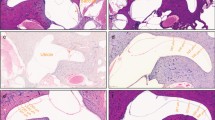Abstract
Past in vivo studies in humans showed that the tympanic membrane (TM) is permeable to physiological gases. Animal studies show that transTM CO2 conductance is increased by TM pathology. The objective of the study was to determine if transTM CO2 exchange in humans is affected by atrophic and sclerotic pathologies. The study used an ear canal (EC) probe (ECP) constructed from a custom-fitted acrylic body, a glass capillary tube enclosing an oil meniscus to maintain ambient ECP + EC pressure and a silica glass microtube linked to a mass spectrometer (MS) for measuring gas composition that was hermetically sealed within the ear canal of the test ear. ECP + EC volume was measured and gas samples taken at 10 min intervals for 1 h. The fractional CO2 pressure measured in the ECP + EC for each sample was regressed on time and the slope of the function multiplied by the ECP + EC volume and divided by the estimated transTM CO2 gradient at the start of the experiment to yield transTM CO2 conductance (µL/min/Pa). Data were complete for 15 normal, 13 sclerotic and 9 atrophic TMs. The average (+std) transTM CO2 conductances were 1.76 × 10−4 + 7.27 × 10−5, 2.26 × 10−4 + 1.5 × 10−4 and 2.36 × 10−4 + 1.14 × 10−4 µL/min/Pa/TM for the normal, sclerotic and atrophic TMs, respectively. A pairwise comparison of data for the normal and atrophic TMs under the directional hypothesis of a greater CO2 exchange rate for thinner TMs approached statistical significance (P = 0.07). A similar pairwise comparison for the sclerotic and normal TMs did not approach statistical significance (P = 0.28). The effect of TM pathologies on CO2 conductance was limited.

Similar content being viewed by others
References
Yuksel S, Douglas Swarts J, Banks J, Seroky JT, Doyle WJ (2009) In vivo measurement of O(2) and CO(2) gas exchange across the human tympanic membrane. Acta Otolaryngol 129:716–725
Kanick SC, Doyle WJ (2005) Barotrauma during air travel: predictions of a mathematical model. J Appl Physiol 98:1592–1602
Dueker CW, Lambertsen CJ, Rosowski JJ, Saunders JC (1979) Middle ear gas exchange in isobaric counter diffusion. J Appl Physiol 47:1239–1244
Ranade A, Lambertsen CJ, Noordergraaf A (1980) Inert gas exchange in the middle ear. Acta Otolaryngol Suppl 371:1–23
Doyle WJ, Alper CM, Seroky JT, Karnavas WJ (1998) Exchange rates of gases across the tympanic membrane in rhesus monkeys. Acta Otolaryngol 118:567–573
Felding UN, Banks JM, Doyle WJ (2004) Gas diffusion across the tympanic membrane in chinchillas: effect of repeated perforations. Auris Nasus Larynx 31:353–359
Elner A (1970) Gas diffusion through the tympanic membrane. A model study in the diffusion chamber. Acta Otolaryngol 69:185–191
Piiper J (1970) Various models for analysis of the absorption of inert gases from gas cavities in the body. Respir Physiol 9:74–85
Hergils L, Magnuson B (1990) Human middle ear gas composition studied by mass spectrometry. Acta Otolaryngol 110:92–99
Acknowledgments
The investigators thank James Seroky for assistance with subject recruiting. Supported in part by a grant from the National Institutes of Health (P50 DC007667) and the Hamburg Endowment to the Department of Pediatric Otolaryngology, University of Pittsburgh.
Author information
Authors and Affiliations
Corresponding author
Rights and permissions
About this article
Cite this article
Yuksel, S., Douglas Swarts, J., Banks, J. et al. CO2 gas exchange across the human tympanic membrane is not appreciably affected by pathology. Eur Arch Otorhinolaryngol 268, 203–206 (2011). https://doi.org/10.1007/s00405-010-1368-y
Received:
Accepted:
Published:
Issue Date:
DOI: https://doi.org/10.1007/s00405-010-1368-y




